ICI V Part Three - Preparation
By Ian
Last November, Jacen and I ran an amazing narrative event for 16 players, easily the most complex and successful event we’ve run or attended. This is part three of the deep dive and you can catch up on the event background and goals in previous articles. Today will be the preparations and some of the challenges we faced.
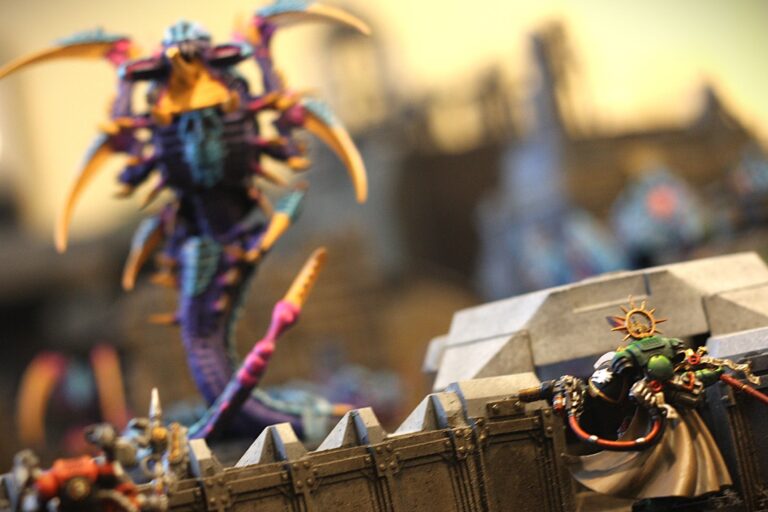
Venue, Music and Feed
We live in the Greater Toronto Area and there was no shortage of event spaces to choose from (as a quick Google search showed). However, many of those venues were also way too expensive for a Warhammer event on a budget.
Jacen eventually found the Monte Carlo in Barrie, about an hour from Toronto (where the majority of players lived) which had a very reasonable rate for a two-day room rental. The first hiccup came when we discovered a hockey tournament had booked up a huge portion of the rooms. Fortunately, there were other hotels on the same street with no shortage of lodgings.
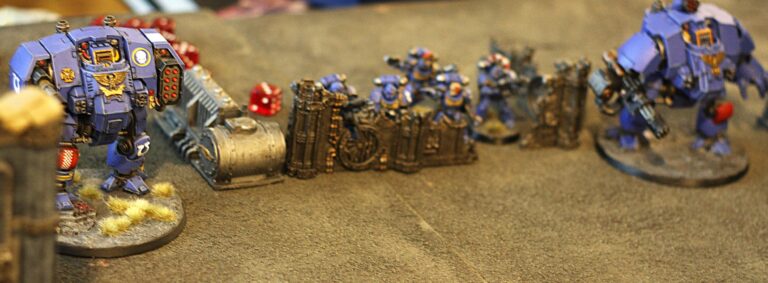
Jacen was the key contact for the hotel and arranged everything, fronting the deposit and signing the paperwork. He was also the only person who saw the room before the event, but closer to the event he went and measured out the space and created a map in the program Cedreo so we could plan the layout. The room included a sound system and projector, which we planned to use for music and to display pairings.
The venue provided tables, but they were smaller than what we needed and we asked players to bring tables and plywood boards. In total, we had nine gaming boards, between 6’ x 4’ and 4’ x 4’. Most of the gaming tables we used were provided by players volunteering supplies.
Though we had coffee and some snacks in the room, players were responsible for their own meals. We booked a large table at a nearby bar for dinner (Beer Town) and there were nearby fast food joints and bakeries for lunches.
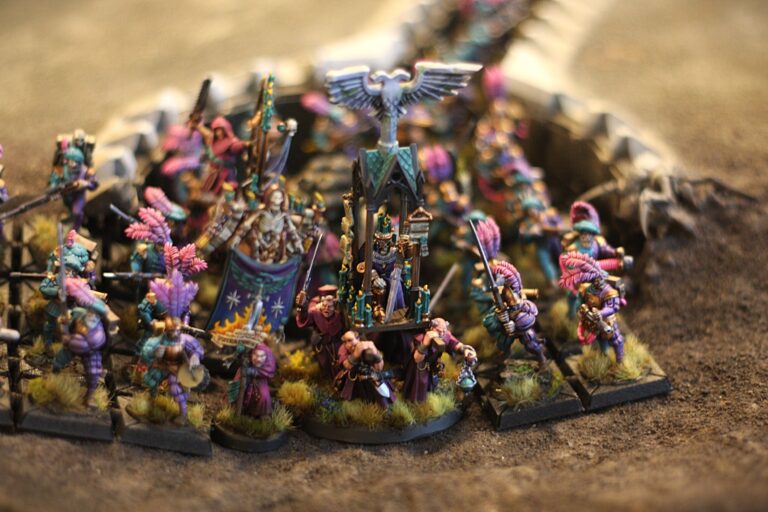
As we needed to provide the boards, a lot of the plywood was brought to Jacen’s place ahead of the event, as he lived closer to the venue. We also picked up terrain from players who couldn’t transport it on the day of and dropped that at Jacen’s place. This necessitated a lot of running around ahead of the event, which looking back was something I’d want to avoid in the future.
Finally, the last thing we wanted for the space was background music and “soundscapes”. Greg has made a few for my bachelor party and we recruited him to do five of them. The idea was to do songs separated by about five minutes of background noise themed to a table (jungle noises, starship sounds, rainstorm, etc.) to created just over two and a half hours of background effects. Each game was scheduled for two hours and forty-five minutes. I made draft playlists for Greg, adding up the song lengths with the five minute breaks to ensure each was the right length, though he had full reign to change the songs however he saw fit. I trusted him completely and just wanted to give him a framework to make his life easier so he wasn’t starting from scratch. He did not disappoint and I’ve even used these soundscapes for my home games since the event

Polls, Players, and Invitations
I mentioned previously that we used Google surveys for a lot of things in this event. The first was an interest poll to gauge who would likely come from our gaming group and which armies they had. I posted this to a group chat and our discord, tagging “@everyone” and we had about a dozen people respond. Some previous attendees did not respond however. Though I was disappointed they hadn’t signed up, I didn’t push it or follow up with them. The event can be a big commitment in terms of painting and just following the narrative and event rules, not to mention a half-hearted player dropping last minute would be a huge pain. At this stage we also asked which armies people were willing to bring and how much terrain and/or folding tables they could provide.
We had a huge response in terms of terrain, with no less than 19 tables of terrain on offer (we would need ten at the most). This allowed us the pick of the litter, and also to put some very dense tables together. The poll also allowed us to collect more mundane things like email addresses and mailing addresses. In the future, I’d also collect phone numbers, as there was a point where we were trying to get a hold of a player running late and it would’ve been great to have their cell handy.
This is an invitational event and we mailed out invitations to players. These were a minimalist design with a striking red on black text and an Inquisitorial “I”. They were mailed out in fancy homemade envelopes and sealed with wax.
Photos by Chaos Zach
The first hurdle we ran into was sending these out. I designed and printed the invitations and envelopes, but Recusant had the wax and Jeff 3D printed the seal. This necessitated a day when I had to run to a Heresy tournament to get the seal off Jeff and then drop it off with the invitations, envelopes and stamps with Recusant. Guess what I’m never doing again? (And, surprise surprise, these driving around errands become a theme in this planning). Next time one (1) person will be handling all the physical parts of the invitations. There was also an issue where my printer ran out of ink and I ended up ordering a second set of invitations and driving them down to Recusant again as we had a second round of invites go out.
Why a second round you ask? The way we handled invitations was to first invite people from our gaming group/previous attendees, then allow them to invite others. This was a pain, and also had a slow trickle of invites going out. A better plan would’ve been to collect all potential invitee information upfront and have a one person handle sending everything out. There can be some stragglers, which is fine, but getting the bulk out would’ve worked best.
The invitations had a website URL which gave all the basic information for the event and a short story as a narrative primer. Jeff did a great job creating the webpage, which acted like an inquisitorial terminal.
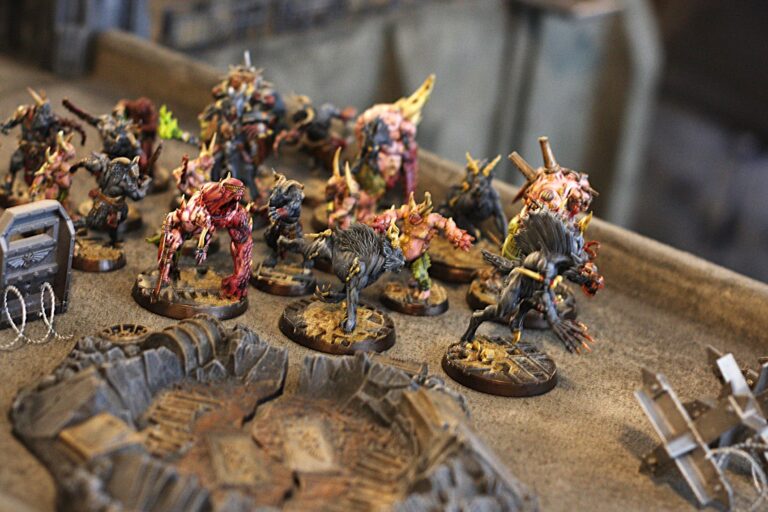
Mission Design and Tables
As I mentioned in a previous post, the goal of the mission design was to have them simple enough so new players would not be overwhelmed. The missions were also to be thematically linked to each table, some with specific objectives built into the terrain.
For the previous ICI, I adapted the “Playing a Game” section from narrative play, which took up six pages and was a total of 26 steps. This was absurd: no one read it, no one followed it. For the ICI V, I distilled the setup rules into theee or four lines of text and used common shorthands: i.e. “Deployment: Dawn of War, 12”, roll off, winner deploys a unit first, then alternate”. There was an appendix explaining each deployment type, but there was no point in laying this out exhaustively. We had nine tables (with 16 players, this gave us one extra to make matchups easier to ensure no one played the same table twice) and eleven missions. Originally, we had planned for ten tables, but when we drafted the matchups, the tenth table was never used. We had drafted one mission per table and one extra, as the Northern Wastes table transformed.
The Dead Hive was my city table and the mission was Necropolis, which was based off of a 9th edition crusade mission that had players searching area terrain. I had played this before and remembered it fondly, so it was a simple matter of adjusting it for 10th edition and tweaking to fit the specific terrain.
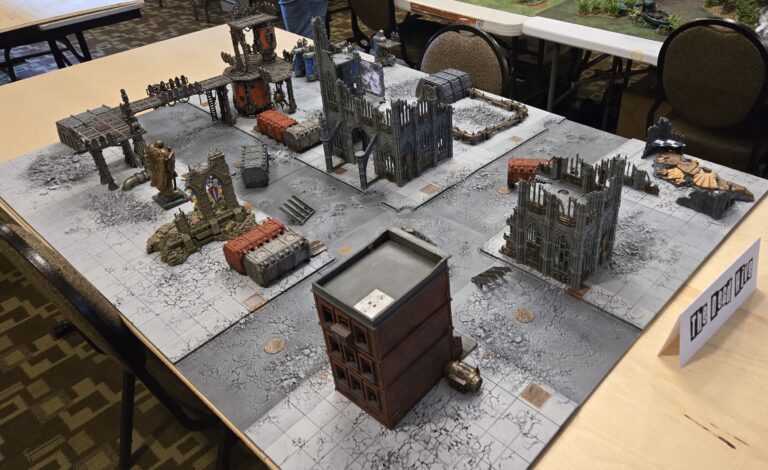
The Forgotten Warzone was Jeff’s stunning trench table which had made an appearance at the last ICI, and the mission was Bunker Assault. The defender had the advantage of having all the objectives in their deployment zone and cover that gave +2 to their save (and allowed saves to increase to a 2+), but the attacker chose who went first.
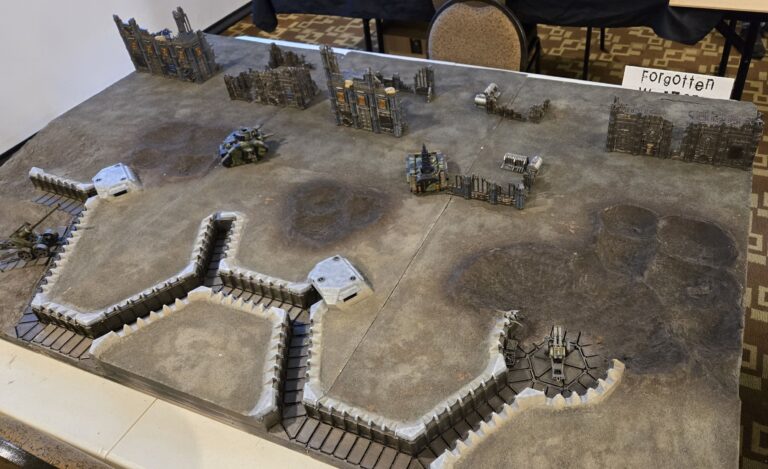
The Deep Forest was two jungle tables placed end-to-end and had two missions (so if a player played on the second jungle table, they wouldn’t play the same mission). The first mission was a classic Ambush, with the defender deploying in a thin column down the middle, lengthwise, and the attacker in a U-shape. The defender’s deployment zone matched up with the next table and we set up matches so the Imperials were being ambushed in the forest the first two rounds (they had clearly chosen a terrible landing zone). These tables were a mix of terrain from Mike, Noah, Mathias, and Jacen, which gave us lots of density.
The second mission on the jungle tables was the Seeing Stones and used hidden deployment markers. We provided players with two sets of tokens numbered 1-20, colour coded for up to four players (the max that would be playing the mission at one time), so one token could be placed next to the unit off the table and the corresponding numbered token could be placed on the board. Tokens moved normally, and were revealed when they came close to an enemy unit/token, objective, or when the owner wished to shoot with the unit.
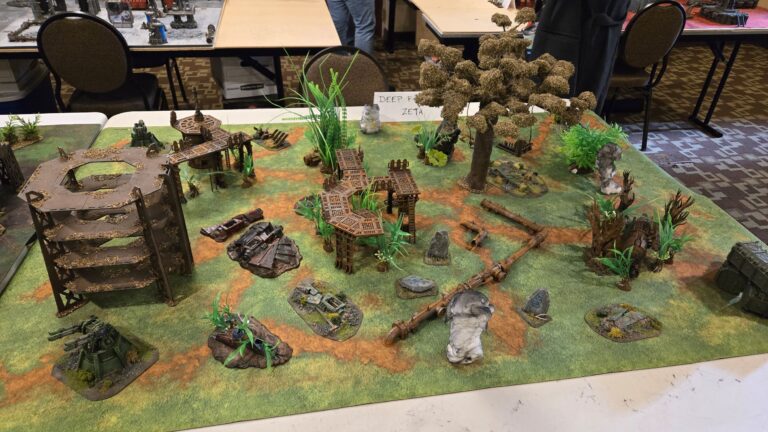
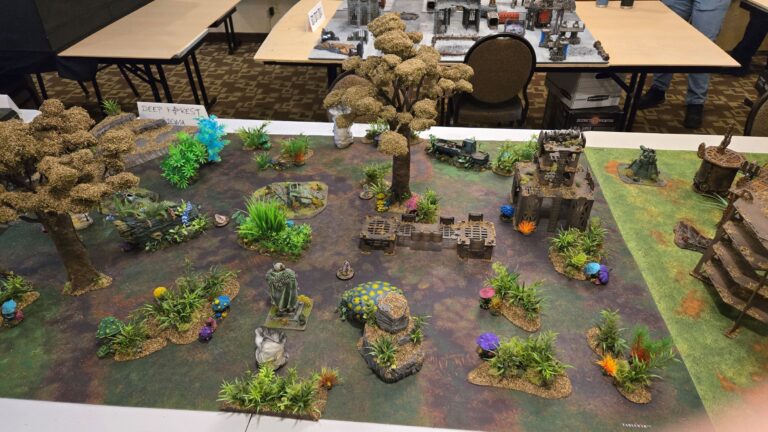
Our Martian desert table, Alpha & Omega Facilities, was originally meant to be two end-to-end tables and hence we wrote two missions for it. This was a fairly dense table of GW style terrain, with two sets of fronteris terrain, an inactive vortex missile battery, and a fortress of redemption: terrain was provided by myself and Chaos Zach. The first mission, Archeotech Hunt, had players fighting over 5 moveable objectives. The second, Uncover the Weapons, had players digging up objectives, with an additional stratagem to power up their unit’s weapons.

The Northern Wastes was an old school GW realm of battle board painted in a snow theme. The first mission, Open the Hatches, was a fairly standard progressive scoring, 5 objective game with a blizzard limiting visibility to 24”. After the first round, we swapped out a tile for the classic Necron tomb tile that used to be available from Forgeworld. The second mission, now on the Necron tomb, was Seize the Stronghold. Each of the four parts of the tomb was an objective, with some spitting mortal wounds at non-Necrons, giving Leadership buffs, or allowing Necrons to teleport in through a gateway.
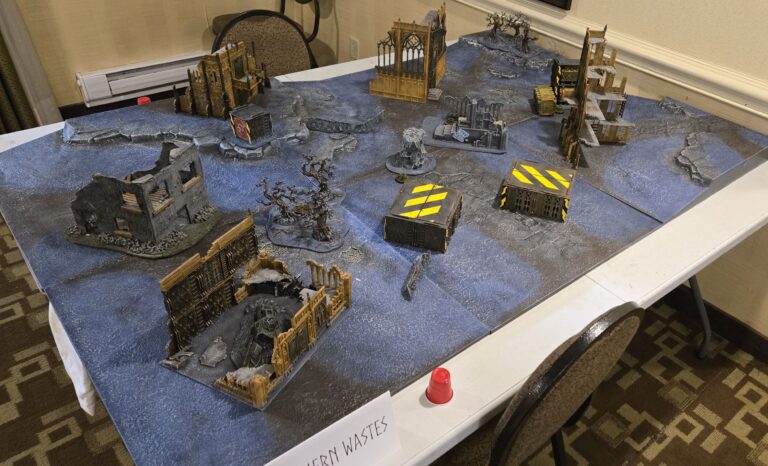
The Albatross was a crashed ghost ship represented by my Zone Mortalis board and Chaos Zach’s set of Boarding Action terrain spread out over four boards rather than two. This mission used the homebrew Zone Mortalis rules, but the objectives were simple progressive scoring for both missions.
The first mission, Explore the Wreck, had rules for the ghost ship opening and closing doors: each player turn a player would roll a D6. On a 1, all doors shut and locked and on a 6 they all opened. The second mission, Wandering Monsters, had automated robots roving the halls attacking both players, though a unit could use consoles to hack and control them. The robot rules were adapted from Jeff’s campaign day for the Tavian Crusade and he provided some Heresy Mechanicum models to be the rocking robots.
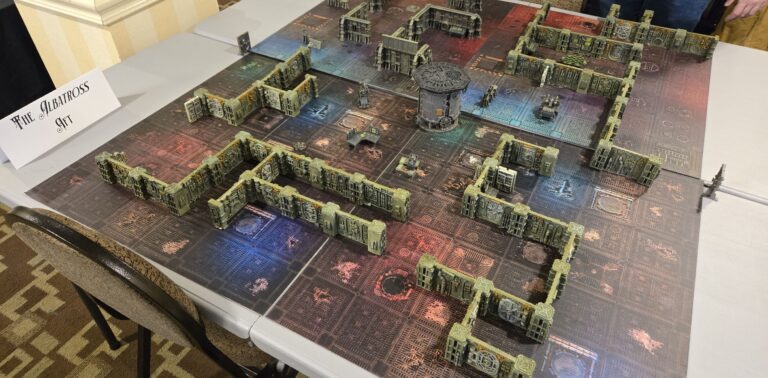
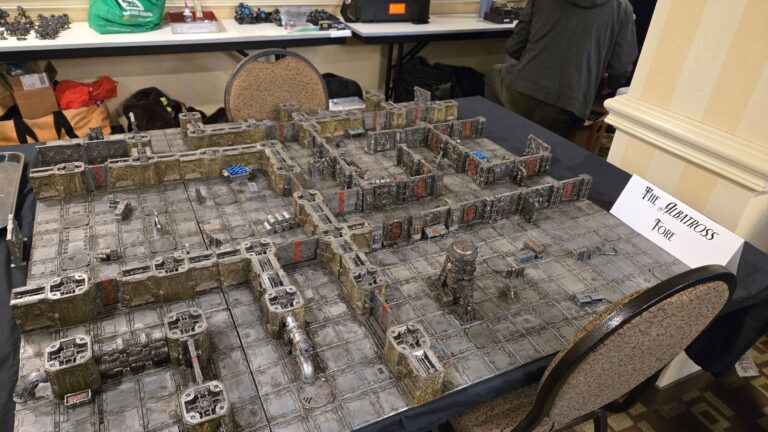
The Spaceport was Jacen’s masterpiece of a table, a huge span across the void, with two landing pads connected to the bridge by walkways, along with a lowered walkway below each concrete cliff face. The objectives were the bridge itself and the two pads. The mission was simple: whoever controls the objectives at the end of the game wins.

Unfortunately, a lot of Real Life™ got in the way during the summer, and we didn’t get a chance to properly playtest anything. Myself, Jacen, and Jeff did playtesting alone (setting up two armies and piloting them both), which I found to be surprisingly helpful, though was no substitute for actual player testing. We also ran out of time to playtest all the missions, and this definitely showed at the event.
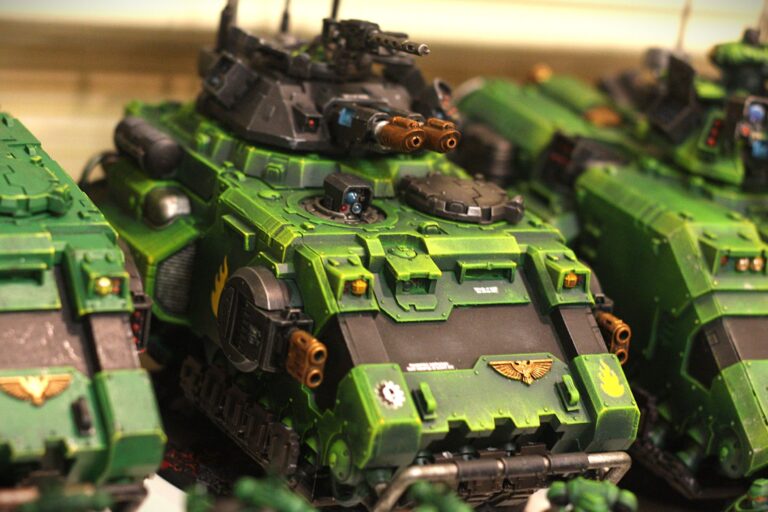
Starting up the Engine
We had designed the story of the event around the search for the Apocrypha Engine, a psychic device of unknown power which had drawn forces from across the sector. They came to the planet Exitus, which, apart from being the name of a Vindicare assassin’s wargear, is Latin for “outcome”. Exploring Exitus and unravelling the mystery of the Engine was a big part of the narrative lead-up to the event, which Recusant and myself handled.
For my stories, I revived an old character: Inquisitor-Knight Samantha Zoar. A hardline Monodominant, she has little tolerance for psykers and won’t let anything stand in her way. She was the point of view character, learning about Exitus with the players. Her segments included interview transcripts and reports from her savants, some speculating on what Exitus was and who inhabited it.
The Imperium is a big place, with a soul-crushing bureaucracy. This gives rise to the question “do planets ever just get forgotten?” Exitus is one such forgotten world, no longer appearing on Imperial charts and the few residents being scavengers. When writing possible backstories for the world, I sprinkled in some player forces, specifically the Ultramarines, Raven Guard, and Salamanders.
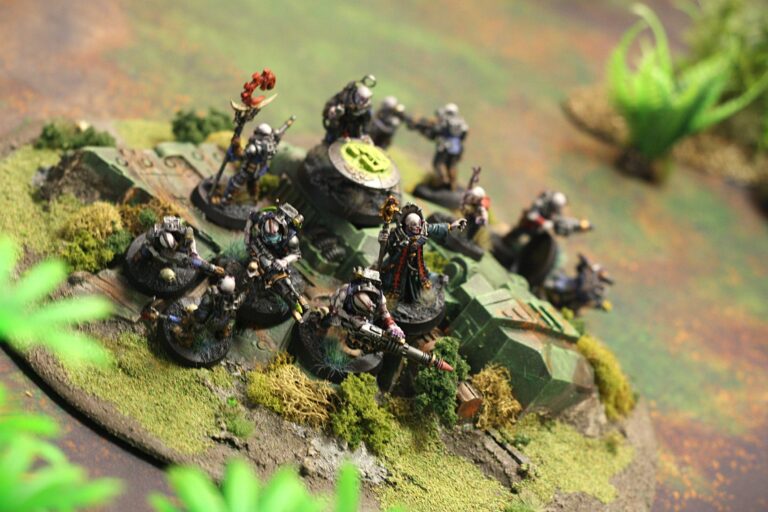
Contemporary Exitus was mostly inspired by Jared Diamond’s Guns, Germs and Steel, and I used a lot of this book to plan how society on Exitus actually functioned. The population was small and constantly at war, so the few population centres hadn’t progressed past the size of a large town, with many of the tribes still hunter-gatherers; albeit scavenging technology or being the descendants of forgotten soldiers. It might be a planet based on real anthropology, but it’s still 40k!
The Remnant or the Warborn were originally inspired by the Warblind from Dan Abnett’s Pariah. The Remnant are descendants of soldiers from forgotten wars, an insular group who raid each other and the other residents of Exitus. Recusant really nailed them with this passage:
They’ve been fighting over that hill for generations—that’s all they call it. The Hill. Two regiments from armies nobody remembers anymore, killing each other for a cause they can no longer name with the same hand-me-down guns and scavenged bullets. The Hill stands taller than ever, stacked high with their corpses.
Finally, the Apocrypha Engine itself. Apocryphal texts are non-canonical religious works. Early on, I joked that the Apocrypha Engine was a goblin hewer-like war machine that fired books at people.
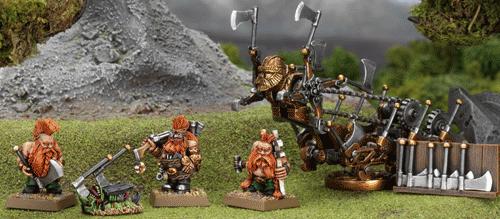
The Engine is psychic, that much we outlined in the event brief, but beyond that we left it pretty ambiguous, though we hinted at various possibilities. Is it a database of secret knowledge, hidden by the Ecclisiarchy that could be damaging to the state religion? Is it a powerful, forbidden weapon? A psychic device, one that could break the grip of the Hive Mind, as we suggested in one story?
In the end, I only determined what the Engine actually was a few weeks before the event, and so far I’ve only told Jacen. Players will have to wait til the ICI VI for the story’s climax and the reveal!
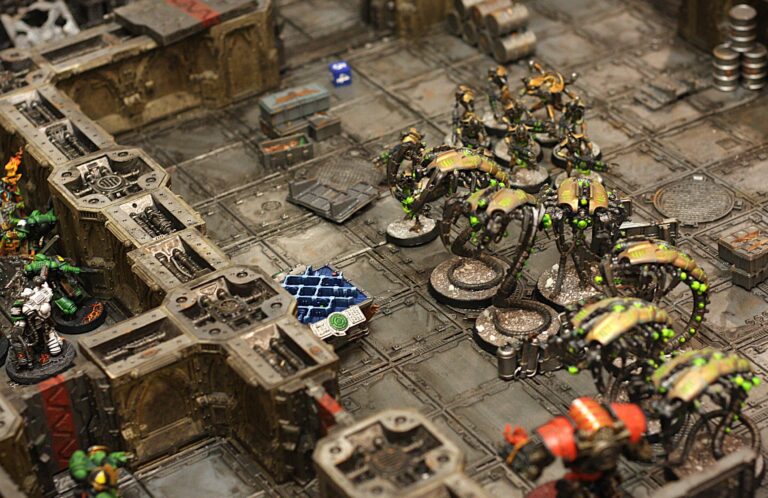
The Campaign Booklet
The ICI V booklet is actually the fifth campaign booklet I’ve created (ICI IV and three previous campaigns). A key difference was I wanted this one to be shareable online without infringing on any copyright, as art in previous booklets was just taken from search engines and uncredited.
Jacen had taken a ton of great army pictures at the ICI IV (indeed, we use them frequently on this blog) and that gave me a great starting point. From there, I supplemented these with images from WikiMedia Commons, ensuring I recorded every image I downloaded so I could source the creator later and credit them as needed.
In addition to images, I played with fonts. Recusant and I drafted a bunch of narrative “tidbits”—pull quotes like the ones you’d find in codicies—and I sprinkled these throughout, often enlarging them with unique fonts to be stand-ins for images.
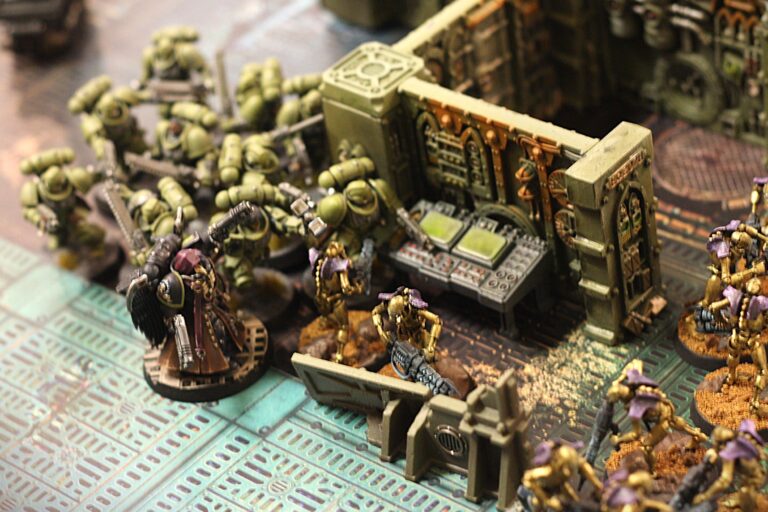
And the fonts. There are over fifty of them in the booklet. Yes, fifty (50) plus fonts. These were sources from dafont.com, specifically using the 100% free filters.
A good designer will tell you not to put more than two fonts on a page, with maybe three throughout a book. Harlon Nayl will tell you “you have to understand the rules in the first place if you’re going to break them” (Abnett 278) [Citation]. I did receive some feedback on the fonts being too much, and one player asked for a more readable version, which I provided. But I felt like they served a purpose, and conveyed meaning. Whether it was an inquisitorial report, a note scribbled by hand, or the ravings of a mad Warborn, I tried to select fonts that would speak to or reinforce what was being conveyed by the words.
The inspiration for the intense amount of fonts was from the MorkBorg and Cy-Borg rulebooks, which have similarly bewildering typeface. If you want a wild ride in graphic design, I suggest you pick them up

In the end, this booklet took between 20-40 hours to create and was basically my hobby progress for the fall. It is head and shoulders better than any previous campaign materials I’ve created and I’m immensely proud of it. From the huge “HERESY FOREVER” when you first open the booklet to Recusant’s “Canticle of Exitus” on the back cover, I think it really set the tone for the event.
You can find links to the PDFs (including one formatted for readability) below. I printed them at Staples and, if you want the full experience feel free to print your own copy. These formed part of the keepsakes from the event and I hope the players enjoyed them. If you’re viewing on a monitor, I strongly suggest you use “Two-Page View” when reading.
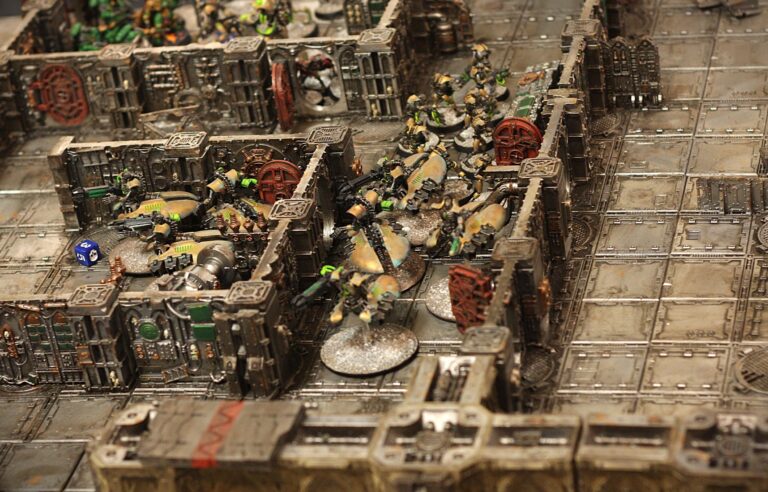
List-vetting & Matchups
For previously ICIs, we didn’t vet lists and had minimal army composition rules…but previous editions of 40k also had more robust army composition rules built into the game. We have a relatively tight-knit club where everyone knows each other and, though there are definitely some stronger players, everyone more or less has the right idea.
But with players new to the group we weren’t sure what they would be bringing. We communicated a strong emphasis from the start on narrative, especially for armies and list building. But we wanted to be sure, especially as some players coming played 40k rarely or were very new to the game (one player had only played four or five games of 40k before the event, others only played 40k at the ICI, some were just recently back into the game, for example).
List vetting in the end was a big stumbling block. Our event was in November and, typically, the third quarter balance changes are released by GW by mid-September after the NOVA Open: last year it wasn’t released until mid-October. Eventually, we just told players to submit lists with the caveat that they could change, creating a second deadline for revised lists.
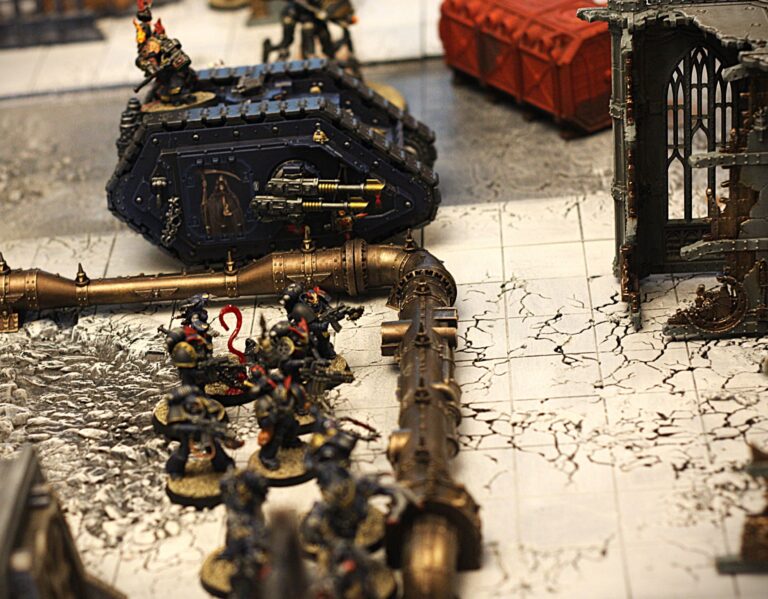
Since the list deadline was only a month before the event, most people were already deep into painting when we reviewed their lists. This of course made it very awkward to ask someone to change their list and in the end we didn’t require anyone to make changes, despite there being a few eyebrow raising lists.
To prep for list vetting, I read Goonhammer’s “Competitive Innovations” series religiously, which goes over weekly tournament results and discusses those lists. This gave me a good baseline for what a 2k tournament list looks like for all the factions attending…though didn’t necessarily translate to a 1,500 point narrative event. Also, some indicies were so limited in unit selection (Votann and World Eaters being good examples) almost every unit in the index showed up or was spammed in one tournament list or another. Finally, though I’m a venerable 40k player, I’m not a tournament goer and don’t have a solid grasp of what makes a competitive list, though, again, that might not even translate to our narrative event with different objectives and game mechanics.
This is all to say that our list-vetting was too late and not stringent enough. More on this in a future article where I’ll discuss lessons from the event.
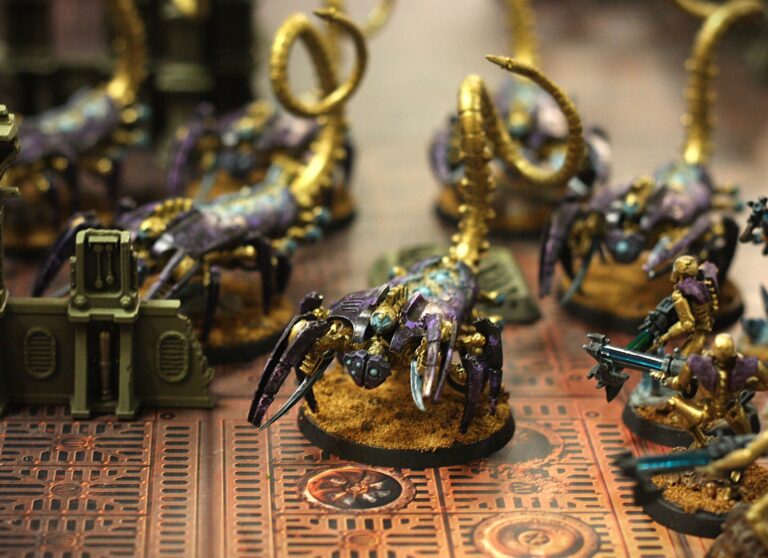
Finally, as this wasn’t a tournament with Swiss pairings or a knockout format, we were free to plan match-ups in advance. Again, we knew who some of the stronger players were in advance and matched them up against each other. We did matchups for four out of five rounds (the third was open where players could pick their opponents) and this was time consuming. We randomized pairings and then tweaked them so that:
- No one played against the same faction more than twice, or the same opponent more than once.
- Everyone payed Zone Mortalis once
- For the end-to-end jungle table, we ensured the same team played the same team, almost as if it was one huge doubles game.
- No one played on the same table twice.
- The newest players were placed near veteran players who knew their army so they could ask questions.
- The newest players did not play those we considered to be on the more competitive side.
As you may imagine, the above made pairings quite complicated and we spent a considerable amount of time on pairings. Again, I’ll discuss some conclusions about this in a later post
There was a projector in the room and we displayed pairings each round using a simple chart in PowerPoint. For the pick your opponent game at the end of day one, we displayed the pairings for the next day so players could ensure they didn’t play the same opponent twice.
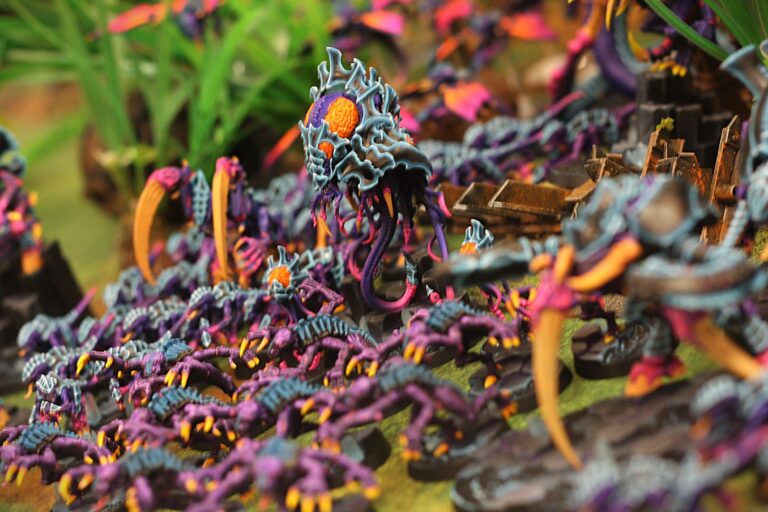
All hail the Administratum
As mentioned, aside from Jacen and myself, we recruited Jeff and Recusant to assist with organizing the event. And, to be clear, “organizing the event” means a few dozen hours worth of meetings.
I can’t really stress enough how thankful I am for those two putting up with Jacen and I and our insane amount of meetings. We had weekly 1-2 hour meetings—sometimes just Jacen and I but usually the four of us—for about 6 months before the event. We created a timeline for when various tasks had to be completed, starting with the event and working backwards, and then worked through that month over month.
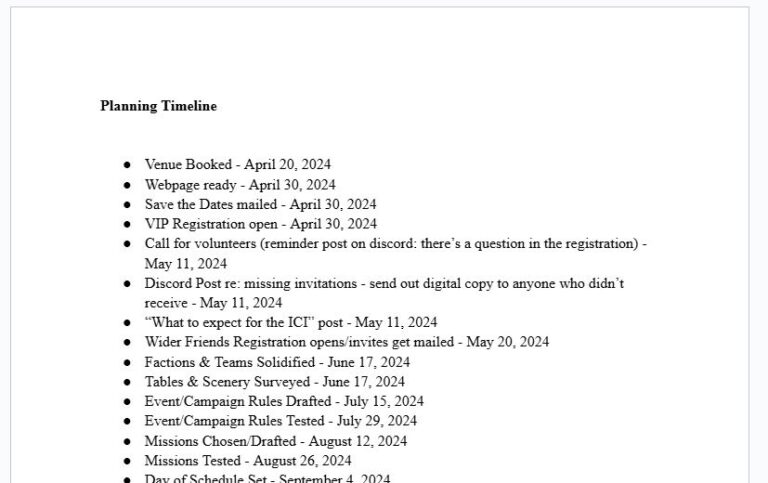
At the end of each meeting, we divvied up tasks to be completed and at the next meeting followed up on them. I’m not going to pretend that we had 100% completion rate and always completed tasks on time, but the frequent meetings were great for keeping us honest, motivated, and on track.
For organizing the various and numerous documents and images we used for the ICI, we had a Google Drive folder and sub-folder that everyone on our little team had access to. This contained everything: general notes on the event, short stories, surveys and survey results, draft email updates to the players, pictures of terrain players were bringing, draft missions and story assets (i.e. cards), and army composition rules to name a few. Having a central place to store all this really helped.
One particular document I’ll call out is the Word doc “Lessons for next ICI”. I had one for the ICI IV and it definitely helped to have a place to just drop bullet points of things I’d do differently next time. In the moment, you think you’ll remember how painstaking, tough, and/or annoying something is, but I for one have found myself in the middle of repeating such a task a year or two later and having sudden flashbacks. Anyway to avoid this fate is helpful.
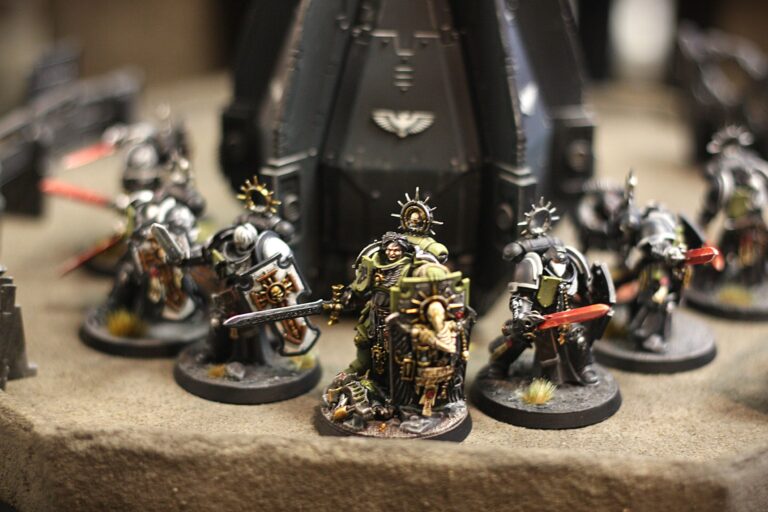
Cards, Accoutrement & Trophies
Narrative play can have a lot of various accessories: cards, tokens, even extra models and the ICI V was no exception.
After each round, the four teams had an opportunity to go on a pseudo vision quest to try to gain bonuses while risking debuffs to their units. Jacen created Tarot cards using artwork we found online here, with each card having a mini game ala Kingdom Death: Monster or Blackstone Fortress. These ranged from rolling on a 2D6 chart, to having characters fight or compete, to Yahtzee-style dice rolling. Each team had six cards, and we displayed these in a “spread” allowing teams to spend Prophet Points they earned from missions. Each round, a team could flip one or two cards, spending a Point for each, allowing a team that fell behind some catch-up opportunities. Jacen printed these double sided on decent paper with a colour printer: they turned out great.
The Prophecy Points themselves were tracked by wooden tokens. I bought circular, 1” discs from the dollar store and sprayed them silver. I started writing Chaos runes on them, but my paint pen ran dry halfway through.
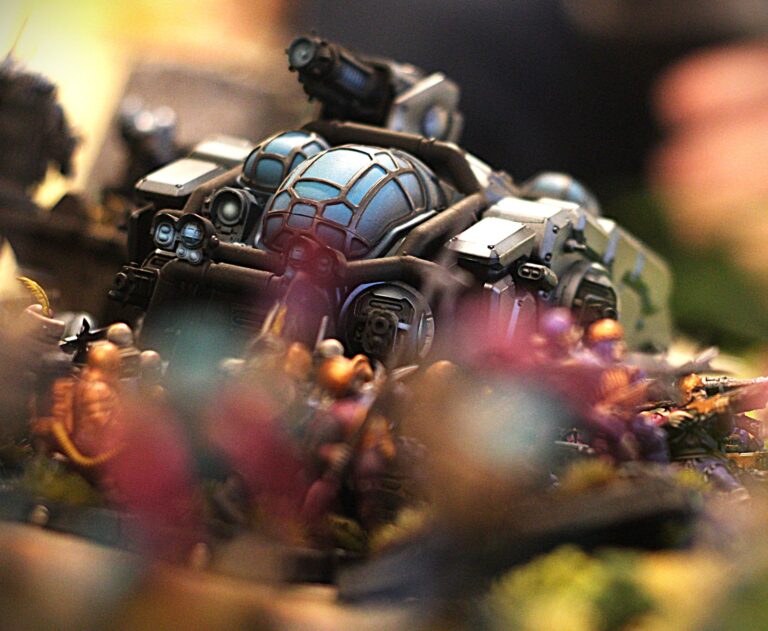
The discs came in packs with different sizes. The smaller discs (about 1.5 cm diameter) were used in the Seeing Stones mission for hidden deployment markers, creating four sets of 40, with each numbered 1-20, as mentioned above. In previous editions when you walked up to a game with hidden deployment, you’d often scramble for markers, tearing up paper and numbering the units on your pen and paper army list. We didn’t want our players to scramble, so when they came to the table they found all the tokens they’d need. At least, I hoped: I figured no one was bringing more than 20 units to a 1,500 point game.
Other than the Tarot cards, we also had “Black” Cards. These were the size of regular playing cards and were printed on basic paper and glued to black cardstock with a glue stick. These warped a bit, but were still quite usable. Each Black Card had a bonus ranging from extra command points to a unit of Warborn (using the rules for a Imperial Guard infantry squad) joining your army from reserves. The Black Cards were a late edition to the planning process, with the idea for them coming only a few weeks before the event. We didn’t actually know how we were going to use them except we knew they would give us an opportunity to put our thumb on the scale for games: more on this in the next article, as they did end up being fairly handy.
I’ve mentioned the booklets were part of the loot for our players, but we wanted include something else. Initially, we thought of doing dice, but these were prohibitively expensive (if you’re doing a large run it can be cost effective, but we only needed 50-100 dice). In the end, we found packs of small dice trays. This had the twofold purpose of giving players a little gift and also encouraging them to keep dice off the tables to improve pictures. Plus, everyone already has dice, but not everyone has a dice tray (well, I mean, now they do…)
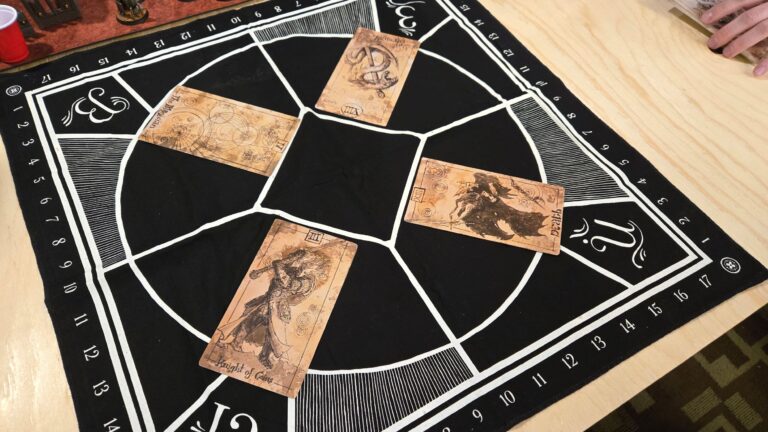
Finally, as is tradition, we gave out a boatload of trophies: 19 to be exact. Trophies are awarded by a rigged election, as I like to call it: players are given a ballot (again, another Google survey) and then Jacen and I looked at the results and used them as a rough guide. The goal is to make sure everyone gets a trophy, but this approach also allows us to sidestep the possibility of the trophies becoming popularity awards. Some players are new and some are well known quantities and we didn’t want anyone to get overlooked.
Traditionally, I made the trophies from random things I found at the dollar store, hot glued to a wooden plaque from an art store, and the name sharpied onto the front, sometimes sprayed gold. This time, they were made from random 3D objects Jeff found STLs for on the internet, hot glued to an art store plaque, sprayed gold, and the labels printed. I think they turned out quite nice
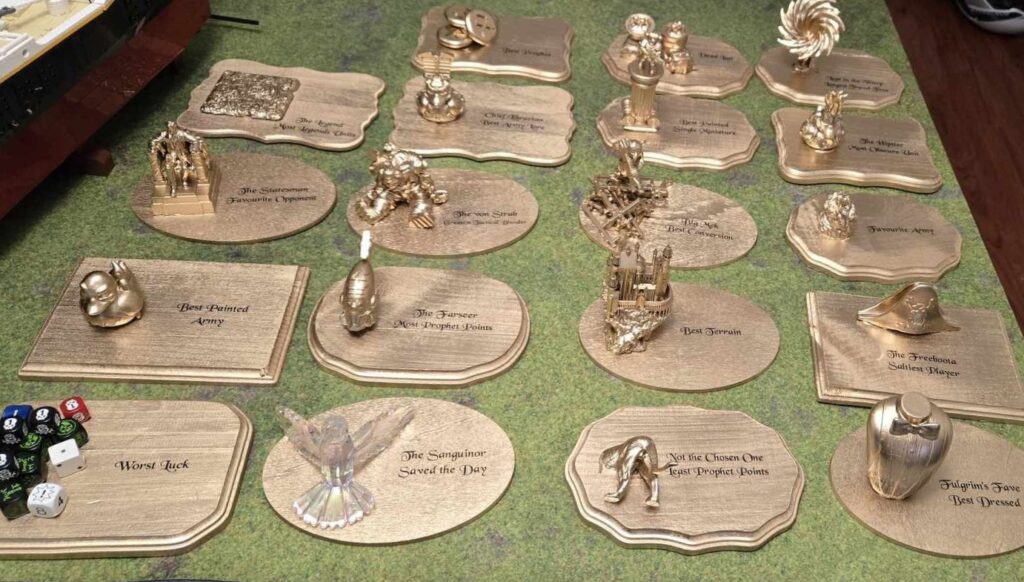
The labels were set to the size of business cards and designed in Microsoft Publisher, printed on transparent sticker paper and cut out. Jeff put the trophies together, and I told him the size of the labels ahead of time so he could leave enough room.
The trophies were, in no particular order:
- Best Painted Single Miniature
- Best Prophet Model
- Big Mek (Best Conversions)
- Chief Librarian (Best Army Lore or Theme)
- Fulgrim’s Fave (Best Dressed/Best Cosplay)
- The Farseer (Most Prophet Points)
- Not The Chosen One (Least Prophet Points)
- Worst Luck
- Dead Last
- Favourite Army
- Best Painted Army
- The von Strab (Greatest Tactical Blunder)
- Lost in the Warp (Longest Travel Time to the Venue)
- The Hipster (Most Obscure Unit)
- The Freeboota (Saltiest Player)
- The Sanguinor (Player Who Saved The Day)
- The Legend (Most Legends Units)
- Best Terrain
- The Statesman (Favourite Opponent)
You’ve heard of soft scores? We have the softest scores.
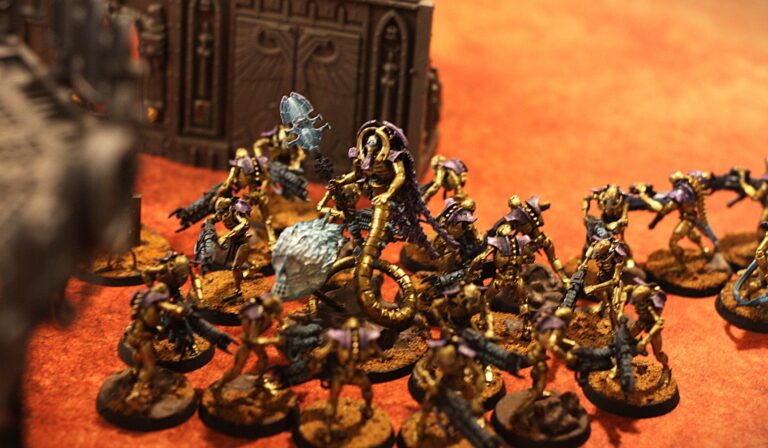
Prophets
Fortune telling, far-seeing, prophecy. These were primary themes for the event and part of the mission rules required players to use their Prophets to interact with the mechanics.
Each player was required to bring a Prophet model in addition to their army. We left the guidelines for the Prophet models intentionally vague and open: the goal was to let our players’ creativity and hobby skills have full reign. A Prophet could be an infantry model, on a base size up to 50mm (60mm if they really, really pushed it), and were, in essence, a non-combatant. That was the brief.
Writing the rules for the Prophets was difficult. The missions often put them at the forefront: some Prophecy Points were achieved by having your Prophet in your opponent’s deployment zone or the centre of the battle. Several had them performing actions around the table. In several objectives, you rolled a D6 and hid the result. One of these determined if your Prophet’s objective was survival or martyrdom.
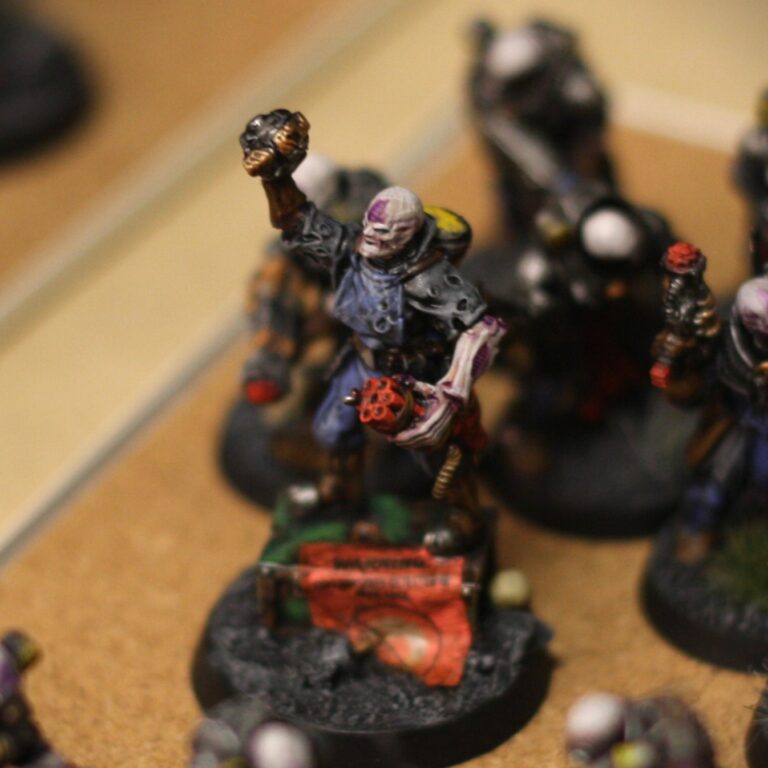
This all meant that Prophets had to be survivable, and we wanted them to be equal as much as possible. Early on we decided that their defensive stats should all be very similar: if one has a higher toughness, for example, it would have less wounds. The weapons were also very mediocre and comparable, and were written based on how the Prophet was modelled. For example, if one had a pistol, it would have less melee attacks. Finally, each moved 6”.
The special rules were more of a challenge. Prophets were Leader units that could join Battleline units. But since Battleline units varied greatly in survivability and numbers, we had to be careful. All Prophets had a 4+ invulnerable save and we wanted them to pass this along to the unit. In the end, we made it a sliding scale: 6+ invul if the unit is eleven or more models, 5+ if it is ten or less, with the invulnerable save improving if a big squad dropped below eleven.
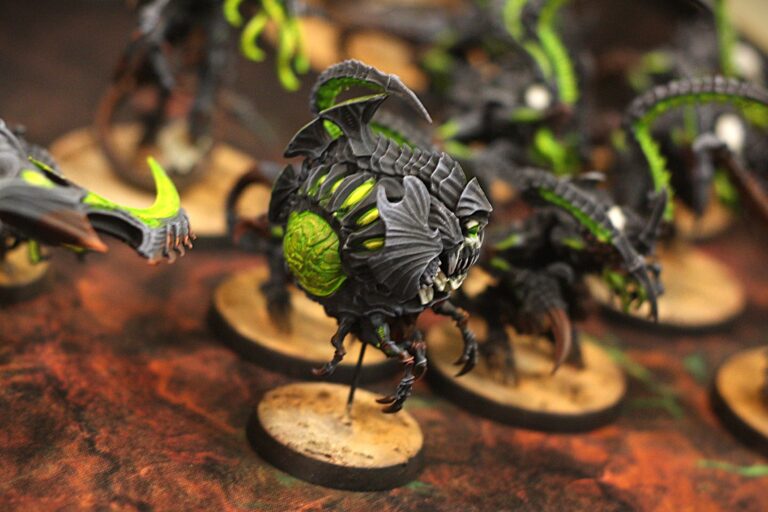
We also made the Prophet immune to the Precision rule (this was a big debate at a meeting, but in the end felt having your Prophet be sniped would be a feels bad moment that outweighed any potential cool factor), gave them Lone Operative when not attached to a unit, and wrote a rule that they could not be killed by ranged attacks that originated more than 12” away (i.e. if their Bodyguard unit is destroyed, additional wounds wouldn’t roll into them). Finally, we included a rule that they could not be placed in Reserves nor embark onto transports, sidestepping the possibility of them being hidden off the table, moving really fast, or outflanking late game onto an objective.
All combined, we felt this made them reasonably survivable and took away a lot of ways they could be abused. This was all drafted late in the process and we didn’t have time to fully playtest the rules, but I felt the theory was strong, and I knew the missions inside and out by that point.
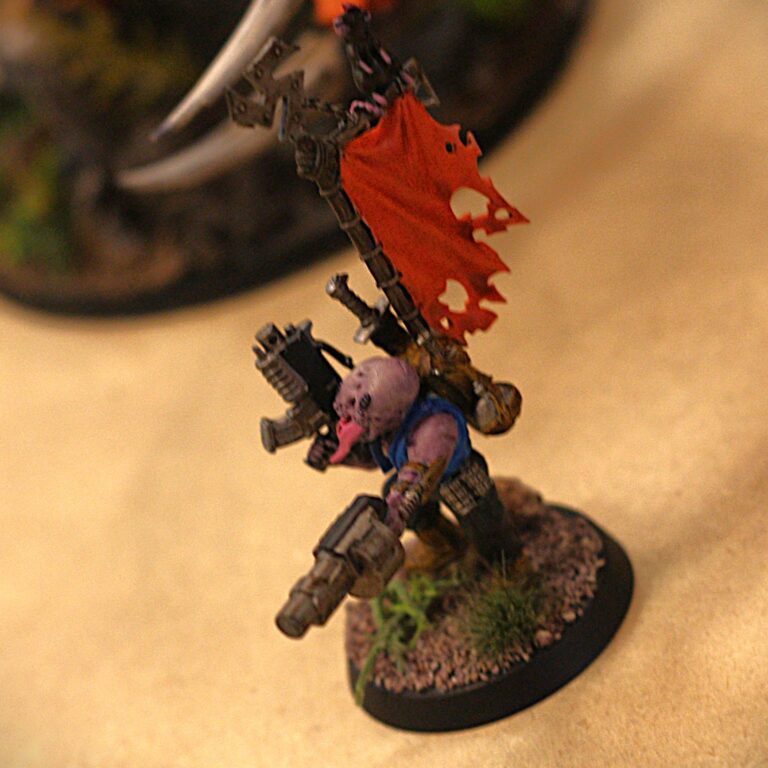
Thanks for coming to my ted talk
Damn, this piece went way longer than I intended, now clocking in at over 5,500 words.
If you’ve made it this far, thanks for sticking with it. I hope this has provided some insight into the process of planning a stupidly complex narrative event, or at least given you a few ideas. Linked below are many of the resources we used.
I’m always happy to talk shop, answer questions, or hear about other events: why not drop us a line at contactus@wrongsideofthemaelstrom.com?
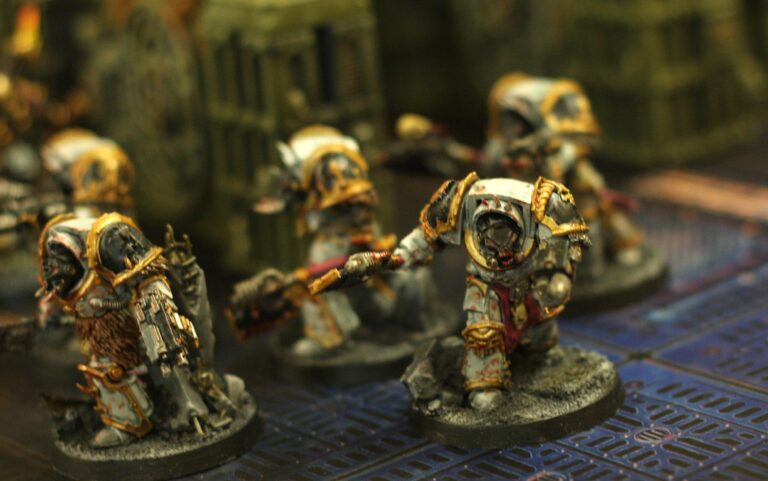
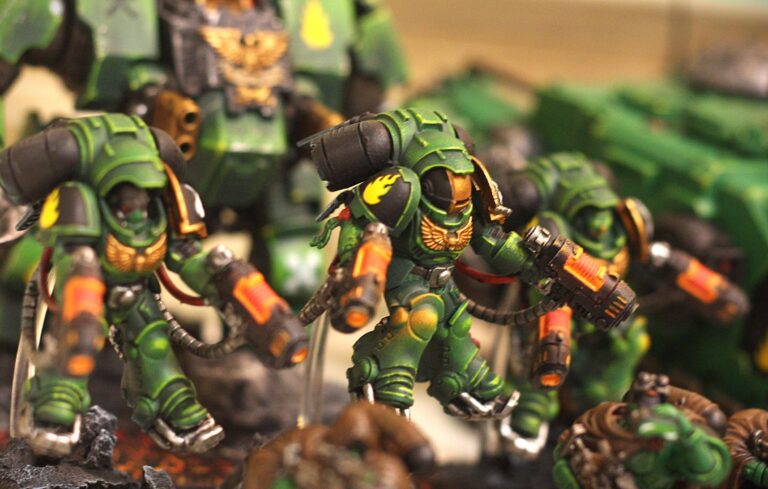
Bibliography
Abnett, Dan. Malleus. Annotated and illustrated ed., Black Library, 2024.
Photo Credits
Unless otherwise noted, all photos by Ian.
Raptors Space Marines by Alys.
Salamanders Space Marines by Greg.
Ultramarines Space Marines by Chris.
Leagues of Votann by Erik.
Word Bearers by Recusant.
Night Lords by Jeff.
White World Eaters by Zach C.
Red World Eaters by Tony.
Black and Green Tyranids by Mike.
Blue and Black Neon Tyranids by Kelly.
Black and Orange Tyranids by Jacen, Greg, Ian, and Elton.
Genestealer Cults by Mathias.
Rogue Trader Imperial Guard by Noah.
Purple and Gold Necrons by Zach D.
Gold, Silver and Green Necrons by Phonsy.